The Influence of Load and Speed on the Initial Breakdown of Rolling Bearings Exposed to Electrical Currents
Abstract
:1. Introduction
2. Materials and Methods
2.1. Experimental Design
2.2. Mechanical Test Setup
2.3. Electrical Test Setup and Evaluation
2.4. Design of Experiments
3. Results and Discussion
3.1. Exemplary Measurement Results at a Single Test Point
3.2. Influence of the Operating Point
4. Conclusions
Author Contributions
Funding
Data Availability Statement
Conflicts of Interest
Abbreviations
| AC | alternating current |
| bd | breakdown |
| ccd | central composite design |
| DC | direct current |
| DoE | design of experiments |
| ir | inner ring |
| or | outer ring |
| rms | root mean square |
Appendix A
| Number | in N | in N | in mm2 | n in min | in V | DoE | in V | in V | |
|---|---|---|---|---|---|---|---|---|---|
| V015 | 1800 | 900 | 20.0 | 5.68 | 7000 | 4 | cubic | 5 | 3 |
| V014 | 1800 | 900 | 20.0 | 5.68 | 7000 | 16 | cubic | 6 | 3.5 |
| V032 | 1800 | 900 | 20.0 | 5.68 | 2000 | 4 | cubic | 3 | 2.5 |
| V035 | 1800 | 900 | 20.0 | 5.68 | 2000 | 16 | cubic | 4.5 | 3 |
| V046 | 1800 | 300 | 9.4 | 5.03 | 7000 | 4 | cubic | 2.5 | 2 |
| V047 | 1800 | 300 | 9.4 | 5.03 | 7000 | 16 | cubic | 3 | 2 |
| V025 | 1800 | 300 | 9.4 | 5.03 | 2000 | 4 | cubic | 3 | 2.5 |
| V016 | 1800 | 300 | 9.4 | 5.03 | 2000 | 16 | cubic | 3.5 | 2 |
| V053 | 600 | 900 | 9.1 | 5.70 | 7000 | 4 | cubic | 2 | 2 |
| V051 | 600 | 900 | 9.1 | 5.70 | 7000 | 16 | cubic | 2.5 | 2 |
| V056 | 600 | 900 | 9.1 | 5.70 | 2000 | 4 | cubic | 1.5 | 1.5 |
| V020 | 600 | 900 | 9.1 | 5.70 | 2000 | 16 | cubic | 2 | 2 |
| V052 | 600 | 300 | 6.7 | 5.03 | 7000 | 4 | cubic | 4.5 | 2 |
| V030 | 600 | 300 | 6.7 | 5.03 | 7000 | 16 | cubic | 2.5 | 2 |
| V054 | 600 | 300 | 6.7 | 5.03 | 2000 | 4 | cubic | 4.5 | 2 |
| V055 | 600 | 300 | 6.7 | 5.03 | 2000 | 16 | cubic | 1.5 | 1.5 |
| V024 | 2040 | 600 | 7.8 | 5.32 | 4500 | 4 | star | 7 | 3 |
| V045 | 2040 | 600 | 7.8 | 5.32 | 4500 | 16 | star | 4.5 | 2 |
| V049 | 360 | 600 | 13.8 | 5.34 | 4500 | 4 | star | 3 | 2 |
| V050 | 360 | 600 | 13.8 | 5.34 | 4500 | 16 | star | 2.5 | 2 |
| V013 | 1200 | 1020 | 7.0 | 5.84 | 4500 | 4 | star | 2.5 | 2.5 |
| V012 | 1200 | 1020 | 7.0 | 5.84 | 4500 | 16 | star | 6 | 2.5 |
| V017 | 1200 | 180 | 14.1 | 4.95 | 4500 | 4 | star | 5.5 | 2.5 |
| V037 | 1200 | 180 | 14.1 | 4.95 | 4500 | 16 | star | 4 | 2.5 |
| V022 | 1200 | 600 | 10.0 | 5.33 | 8000 | 4 | star | 6.5 | 6.5 |
| V042 | 1200 | 600 | 10.0 | 5.33 | 8000 | 16 | star | 4.5 | 2.5 |
| V041 | 1200 | 600 | 10.0 | 5.33 | 1000 | 4 | star | 5 | 2 |
| V036 | 1200 | 600 | 10.0 | 5.33 | 1000 | 16 | star | 2.5 | 2 |
| V044 | 1200 | 600 | 10.0 | 5.33 | 4500 | 4 | central | 7.5 | 2.5 |
| V034 | 1200 | 600 | 10.0 | 5.33 | 4500 | 16 | central | 3.5 | 2 |
| V039 | 1200 | 600 | 10.0 | 5.33 | 4500 | 4 | central | 7.5 | 2 |
| V031 | 1200 | 600 | 10.0 | 5.33 | 4500 | 16 | central | 5.5 | 5.5 |
| V018 | 1200 | 600 | 10.0 | 5.33 | 4500 | 4 | central | 4 | 4 |
| V029 | 1200 | 600 | 10.0 | 5.33 | 4500 | 16 | central | 4 | 2.5 |
| V033 | 1200 | 600 | 10.0 | 5.33 | 4500 | 4 | central | 6 | 6 |
| V038 | 1200 | 600 | 10.0 | 5.33 | 4500 | 16 | central | 5.5 | 4 |
| V043 | 1200 | 600 | 10.0 | 5.33 | 4500 | 4 | central | 7 | 3.5 |
| V011 | 1200 | 600 | 10.0 | 5.33 | 4500 | 16 | central | 3 | 2.5 |
| V023 | 1200 | 600 | 10.0 | 5.33 | 4500 | 4 | central | 0.5 | 0.5 |
| V048 | 1200 | 600 | 10.0 | 5.33 | 4500 | 16 | central | 7 | 2 |
| V027 | 4000 | 600 | 4.2 | 5.28 | 4500 | 4 | extra | 3.5 | 3 |
| V040 | 4000 | 600 | 4.2 | 5.28 | 4500 | 16 | extra | 3 | 2 |
| V028 | 1200 | 2000 | 4.2 | 6.99 | 4500 | 4 | extra | 6 | 6 |
| V026 | 1200 | 2000 | 4.2 | 6.99 | 4500 | 16 | extra | 3 | 2.5 |
Appendix B
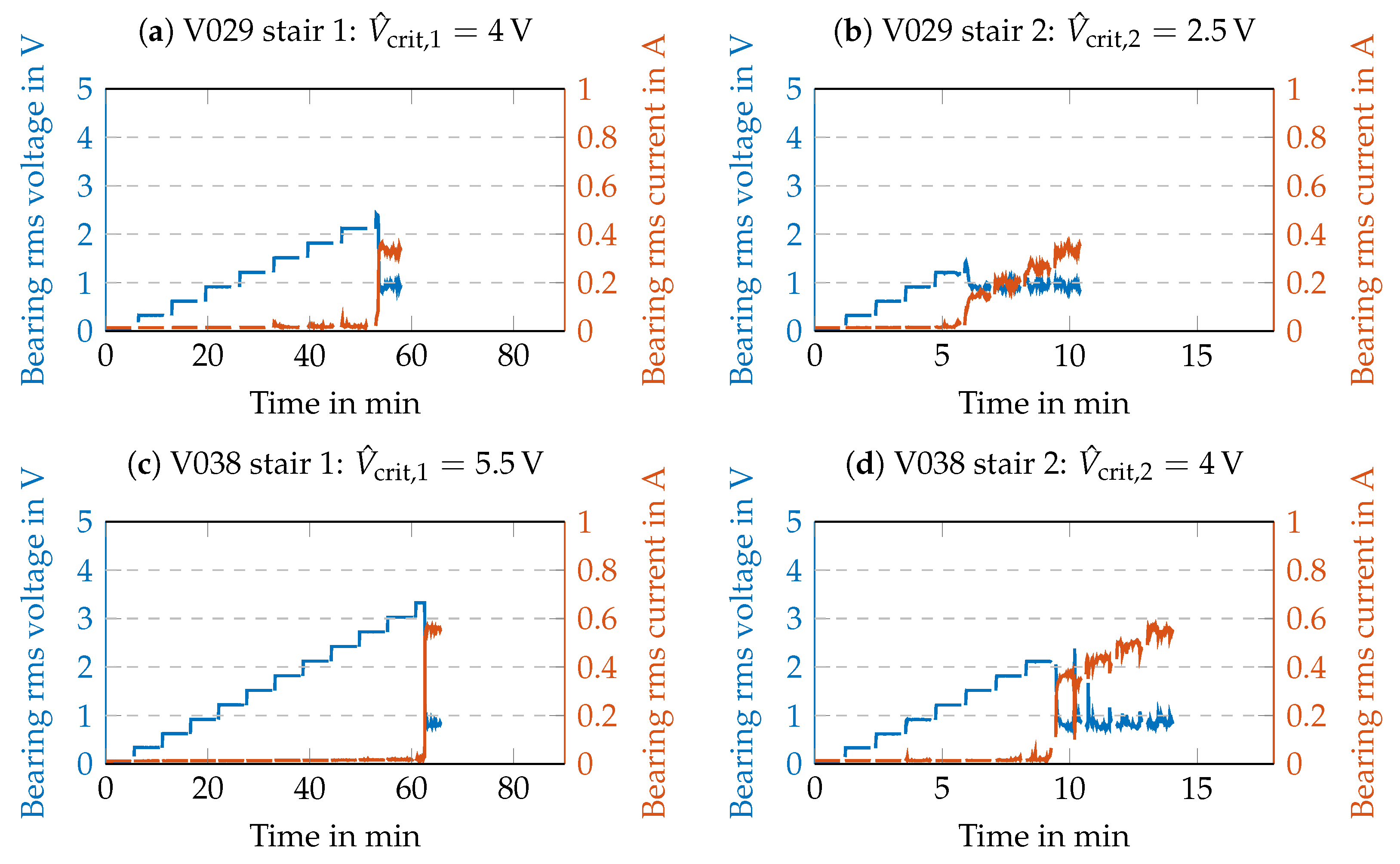
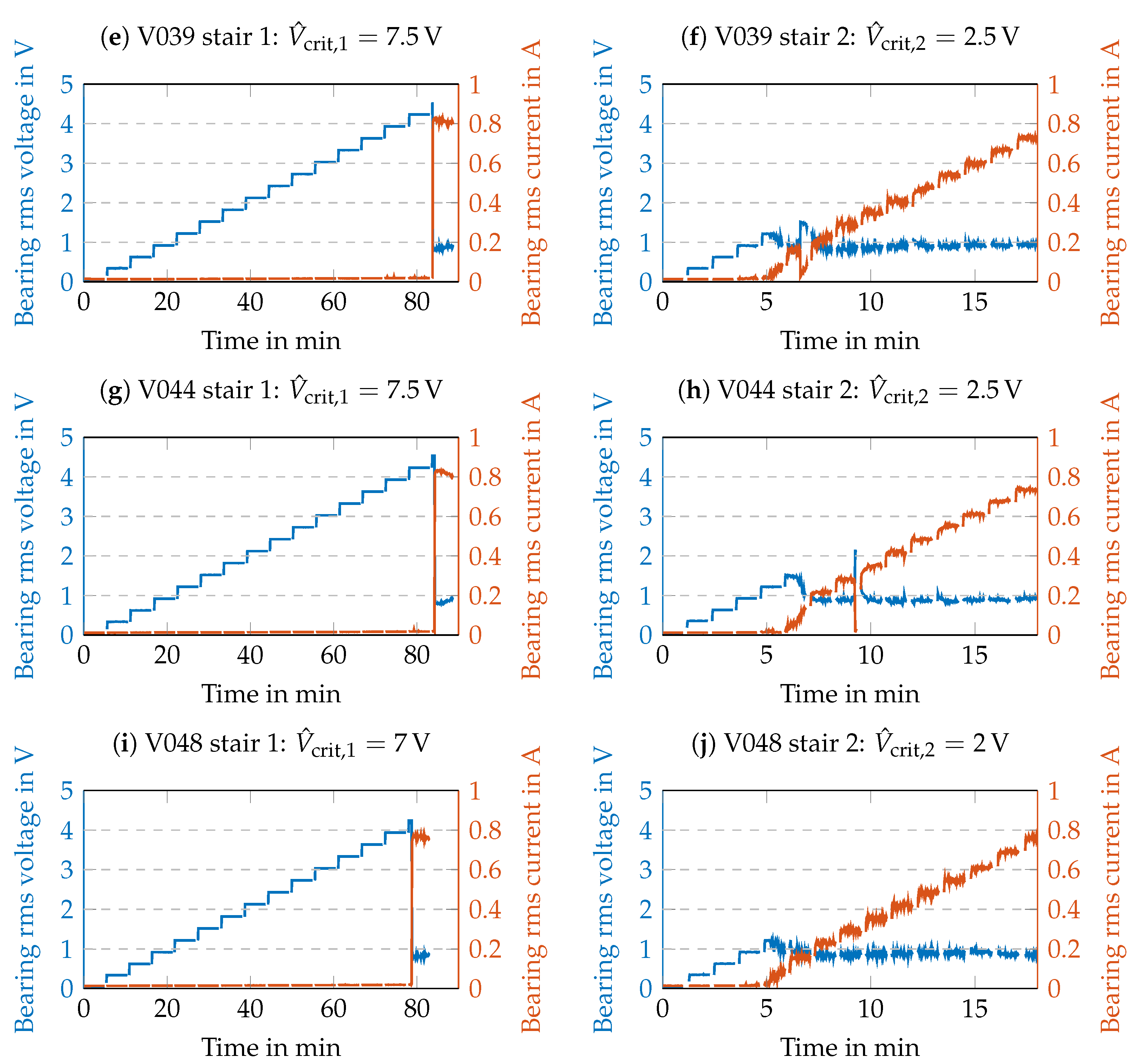
References
- Graf, S.; Capan, R.; Koch, O.; Sauer, B. Electrically induced damage of rolling bearings due to parasitic converter currents in electrical drive trains. In Commercial Vehicle Technology 2022; Proceedings; Berns, K., Dressler, K., Kalmar, R., Stephan, N., Teutsch, R., Thul, M., Eds.; Springer Fachmedien Wiesbaden: Wiesbaden, Germany, 2022; pp. 199–209. [Google Scholar] [CrossRef]
- Schneider, V.; Behrendt, C.; Höltje, P.; Cornel, D.; Becker-Dombrowsky, F.M.; Puchtler, S.; Gutiérrez Guzmán, F.; Ponick, B.; Jacobs, G.; Kirchner, E. Electrical Bearing Damage, A Problem in the Nano- and Macro-Range. Lubricants 2022, 10, 194. [Google Scholar] [CrossRef]
- Furtmann, A.; Tischmacher, H.; Poll, G. Extended HF equivalent model of a drive train. In Proceedings of the 2016 XXII International Conference on Electrical Machines (ICEM), Lausanne, Switzerland, 4–7 September 2016; pp. 2244–2250. [Google Scholar] [CrossRef]
- Kriese, M.; Wittek, E.; Gattermann, S.; Tischmacher, H.; Poll, G.; Ponick, B. Influence of bearing currents on the bearing lifetime for converter driven machines. In Proceedings of the 2012 XXth International Conference on Electrical Machines, Marseille, France, 2–5 September 2012; pp. 1735–1739. [Google Scholar] [CrossRef]
- Mütze, A.; Strangas, E.G. The Useful Life of Inverter-Based Drive Bearings: Methods and Research Directions from Localized Maintenace to Prognosis. IEEE Ind. Appl. Mag. 2016, 22, 63–73. [Google Scholar] [CrossRef]
- Safdarzadeh, O.; Binder, A.; Weicker, M. Measuring Electric Contact in an Axial Ball Bearing at DC Current Flow. IEEE Trans. Ind. Appl. 2023, 59, 3341–3352. [Google Scholar] [CrossRef]
- Dumke, K.; Borsi, H.; Gockenbach, E. Experimental investigations on the behavior of decomposition gases in insulating liquids caused by partial discharge and breakdown. In Proceedings of the 12th International Conference on Conduction and Breakdown in Dielectric Liquids, Roma, Italy, 15–19 July 1996; Mazzetti, C., Ed.; IEEE: Piscataway, NJ, USA, 1996; pp. 436–439. [Google Scholar] [CrossRef]
- Tobazeon, R. Prebreakdown phenomena in dielectric liquids. In Proceedings of the 1993 IEEE 11th International Conference on Conduction and Breakdown in Dielectric Liquids (ICDL’93), Baden-Dattwil, Switzerland, 19–23 July 1993; pp. 172–183. [Google Scholar] [CrossRef]
- Kist, K. Streamerausbreitung im Mischdielektrikum Isolieröl/Transformerboard. Ph.D. Thesis, Logos-Verlag, Berlin, Germany, 1999. [Google Scholar]
- Badent, R.; Julliard, Y.; Kist, K.; Schwab, A. Streamer inception and propagation in insulating liquids with inserted scavenger electrodes. In Proceedings of the 2000 Annual Report Conference on Electrical Insulation and Dielectric Phenomena (Cat. No.00CH37132), Victoria, BC, Canada, 15–18 October 2000; Volume 1, pp. 268–271. [Google Scholar] [CrossRef]
- Ye, W.; Hao, J.; Gao, C.; Zhang, J.; Zhang, J.; Liao, R. Discharge Mechanism Difference Analysis Between Natural Ester and Mineral Oil Under Impulse Electric Field: A DFT Investigation. IEEE Trans. Dielectr. Electr. Insul. 2022, 29, 1803–1810. [Google Scholar] [CrossRef]
- Graf, S.; Koch, O.; Sauer, B. Influence of Parasitic Electric Currents on an Exemplary Mineral-Oil-Based Lubricant and the Raceway Surfaces of Thrust Bearings. Lubricants 2023, 11, 313. [Google Scholar] [CrossRef]
- Graf, S.; Werner, M.; Koch, O.; Götz, S.; Sauer, B. Breakdown voltages in thrust bearings: Behavior and Measurement. Tribol. Trans. 2023, 66, 488–496. [Google Scholar] [CrossRef]
- Ma, J.; Xue, Y.; Han, Q.; Li, X.; Yu, C. Motor Bearing Damage Induced by Bearing Current: A Review. Machines 2022, 10, 1167. [Google Scholar] [CrossRef]
- Mütze, A.; Binder, A. Calculation of Circulating Bearing Currents in Machines of Inverter-Based Drive Systems. IEEE Trans. Ind. Electron. 2007, 54, 932–938. [Google Scholar] [CrossRef]
- Mütze, A.; Binder, A. Calculation of Motor Capacitances for Prediction of the Voltage Across the Bearings in Machines of Inverter-Based Drive Systems. IEEE Trans. Ind. Appl. 2007, 43, 665–672. [Google Scholar] [CrossRef]
- Harder, A.; Piske, L.; Neu, M.; Kirchner, E. Initiierungs- und Abklingeffekte von elektrischen Schädigungsmechanismen im Wälzlager. In Gleit- und Wälzlagerungen 2021; VDI-Berichte, VDI Verlag GmbH: Düsseldorf, Germany, 2021; pp. 65–74. [Google Scholar]
- Joshi, A.; Blennow, J. Investigation of the Static Breakdown Voltage of the Lubricating Film in a Mechanical Ball Bearing. In Proceedings of the Nordic Insulation Symposium, Trondheim, Norway, 9–12 June 2018. [Google Scholar] [CrossRef]
- Schirra, T.; Martin, G.; Neu, M.; Kirchner, E. Feasibility study of impedance analysis for measuring rolling bearing loads. In Proceedings of the 74th STLE Annual Meeting & Exhibition, Nashville, TN, USA, 19–23 May 2019. [Google Scholar]
- Schirra, T.; Martin, G.; Puchtler, S.; Kirchner, E. Electric impedance of rolling bearings—Consideration of unloaded rolling elements. Tribol. Int. 2021, 158, 106927. [Google Scholar] [CrossRef]
- Martin, G.; Becker, F.M.; Kirchner, E. A novel method for diagnosing rolling bearing surface damage by electric impedance analysis. Tribol. Int. 2022, 170, 107503. [Google Scholar] [CrossRef]
- Harder, A.; Zaiat, A.; Becker-Dombrowsky, F.M.; Puchtler, S.; Kirchner, E. Investigation of the Voltage-Induced Damage Progression on the Raceway Surfaces of Thrust Ball Bearings. Machines 2022, 10, 832. [Google Scholar] [CrossRef]
- Gonda, A.; Capan, R.; Bechev, D.; Sauer, B. The Influence of Lubricant Conductivity on Bearing Currents in the Case of Rolling Bearing Greases. Lubricants 2019, 7, 108. [Google Scholar] [CrossRef]
- Mütze, A. Bearing Currents in Inverter-Fed AC-Motors; Berichte aus der Elektrotechnik; Shaker: Aachen, Gernamy, 2004. [Google Scholar]
- Tischmacher, H. Bearing Wear Condition Identification on Converter-fed Motors. In Proceedings of the 2018 International Symposium on Power Electronics, Electrical Drives, Automation and Motion (SPEEDAM), Amalfi, Italy, 20–22 June 2018; pp. 19–25. [Google Scholar] [CrossRef]
- Puchtler, S.; Maier, R.; Kuhn, M.; Burkhardt, Y. Der initiale elektrische Durchschlag: Einflüsse und Auswirkungen. In Gleit- und Wälzlagerungen 2023; VDI-Berichte, VDI Verlag GmbH: Düsseldorf, Germany, 2023; pp. 21–29. [Google Scholar]

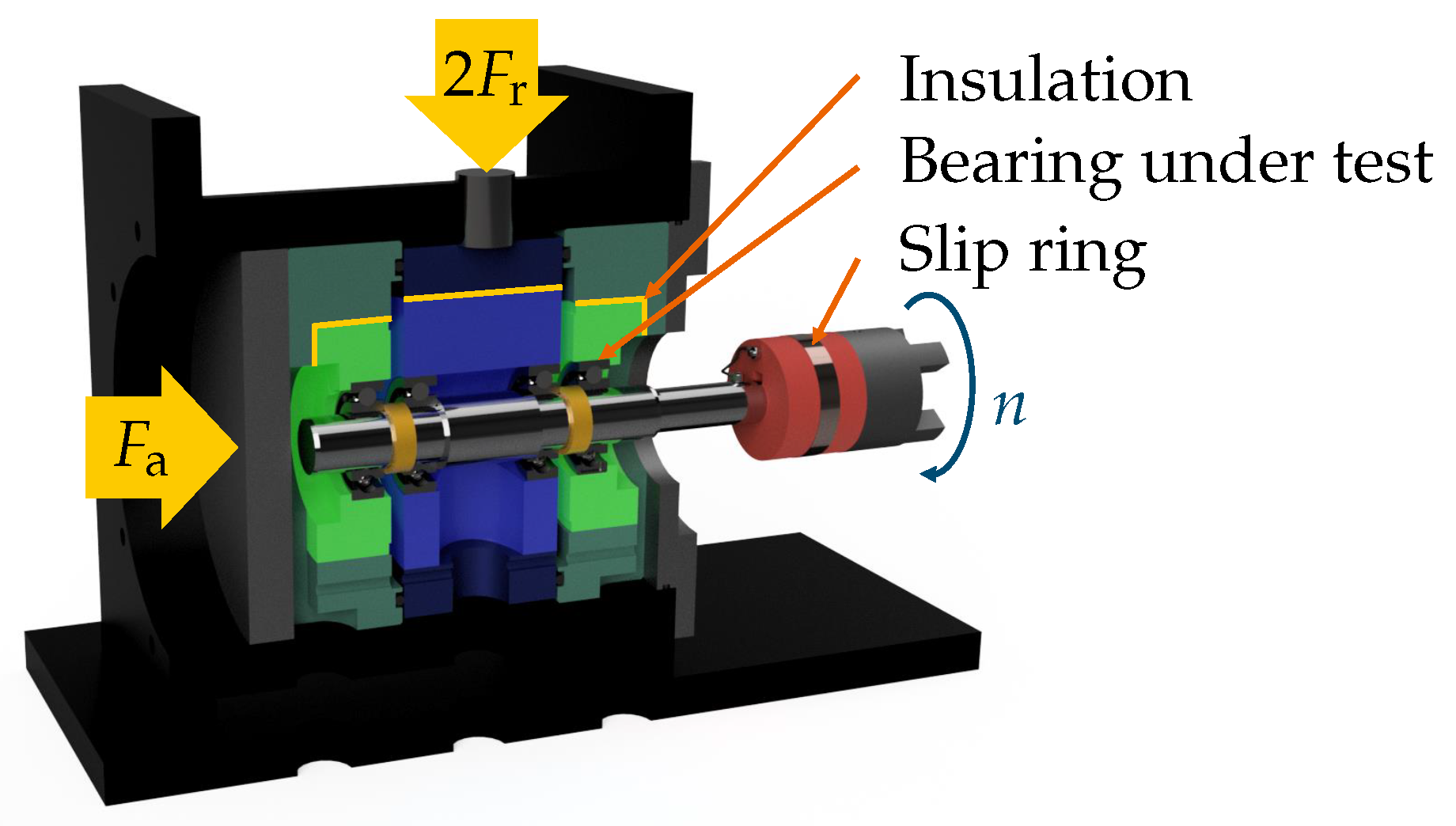

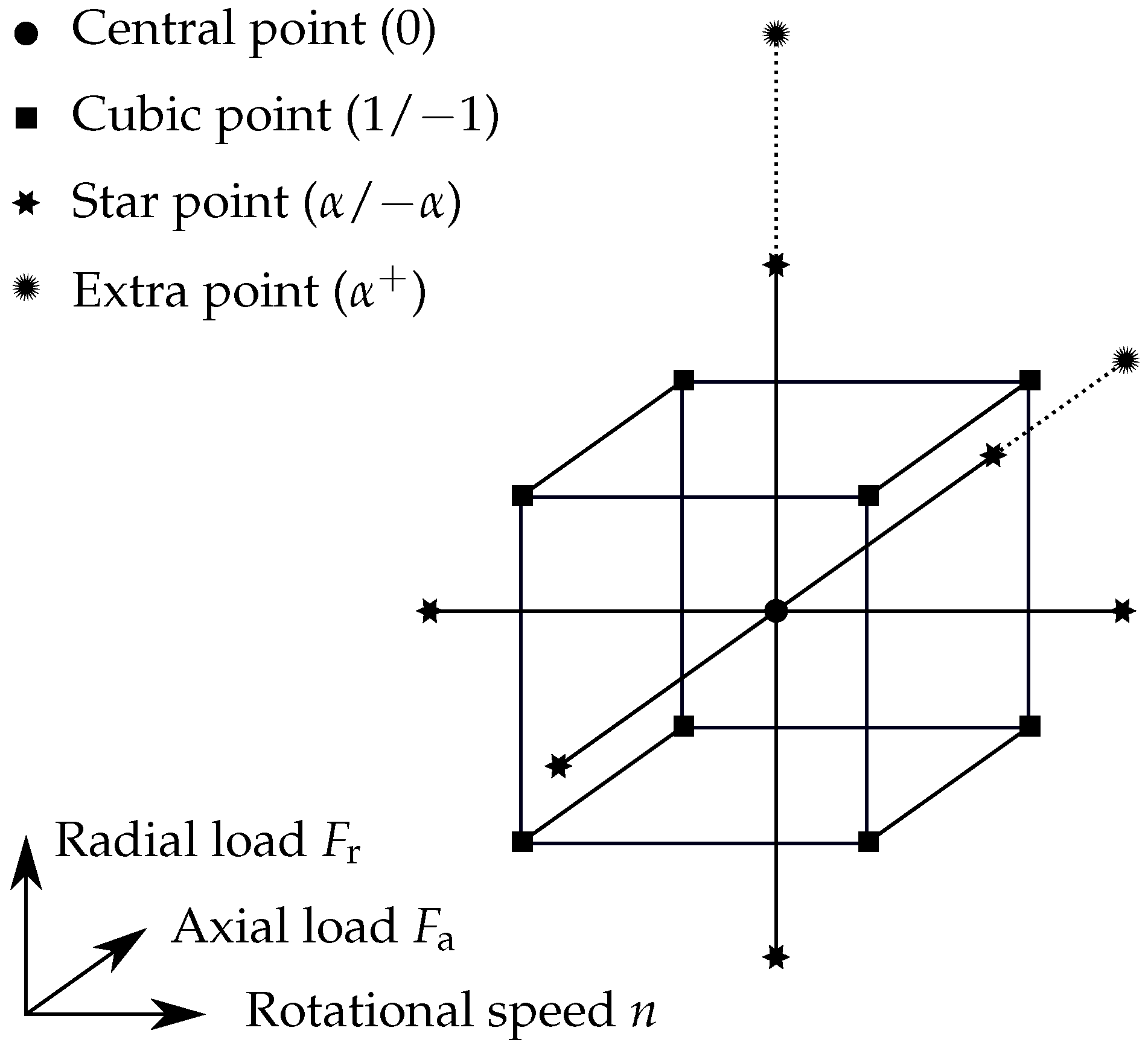



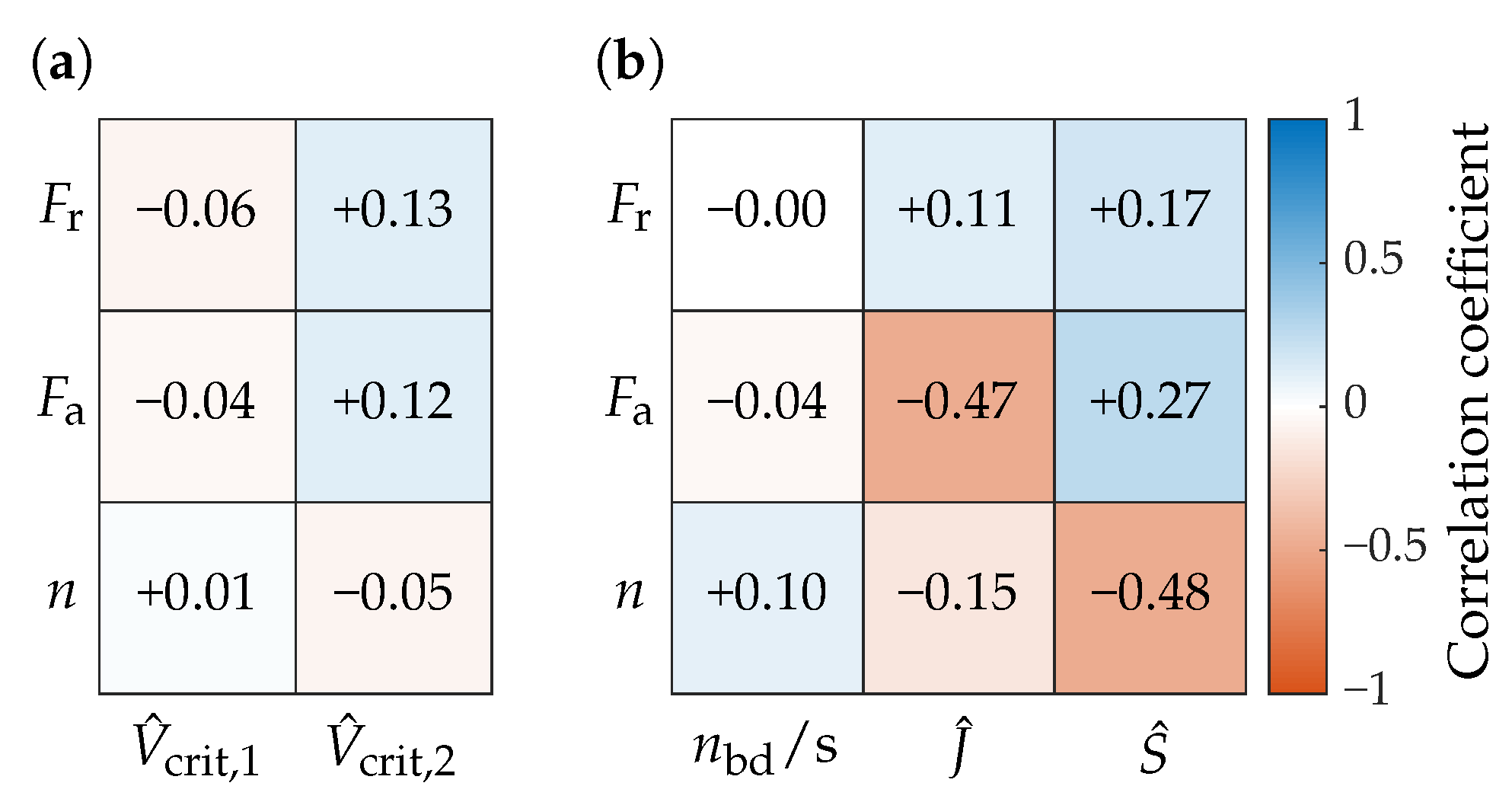
| Level | Radial Load in | Axial Load in | Speed in |
|---|---|---|---|
| 360 | 180 | 1000 | |
| 600 | 300 | 2000 | |
| 0 | 1200 | 600 | 4500 |
| 1 | 1800 | 900 | 7000 |
| 2040 | 1020 | 8000 | |
| 4000 | 2000 | - |
Disclaimer/Publisher’s Note: The statements, opinions and data contained in all publications are solely those of the individual author(s) and contributor(s) and not of MDPI and/or the editor(s). MDPI and/or the editor(s) disclaim responsibility for any injury to people or property resulting from any ideas, methods, instructions or products referred to in the content. |
© 2023 by the authors. Licensee MDPI, Basel, Switzerland. This article is an open access article distributed under the terms and conditions of the Creative Commons Attribution (CC BY) license (https://creativecommons.org/licenses/by/4.0/).
Share and Cite
Puchtler, S.; Maier, R.; Kuhn, M.; Burkhardt, Y. The Influence of Load and Speed on the Initial Breakdown of Rolling Bearings Exposed to Electrical Currents. Lubricants 2024, 12, 1. https://doi.org/10.3390/lubricants12010001
Puchtler S, Maier R, Kuhn M, Burkhardt Y. The Influence of Load and Speed on the Initial Breakdown of Rolling Bearings Exposed to Electrical Currents. Lubricants. 2024; 12(1):1. https://doi.org/10.3390/lubricants12010001
Chicago/Turabian StylePuchtler, Steffen, Robert Maier, Martin Kuhn, and Yves Burkhardt. 2024. "The Influence of Load and Speed on the Initial Breakdown of Rolling Bearings Exposed to Electrical Currents" Lubricants 12, no. 1: 1. https://doi.org/10.3390/lubricants12010001






